Climate change is expected to expose humankind to major physical risks, such as serious natural disasters.
In June 2020, we reviewed our “K” LINE Environmental Vision 2050, and based on the results of the scenario analysis proposed by the Task Force on Climate-related Financial Disclosures (TCFD), identified issues to be addressed and revised some targets.
Furthermore, in November 2021, we recognized global climate change countermeasures as an issue that must be strengthened by the entire international community, and we therefore set a higher challenge of net-zero GHG emissions by 2050. In addition, as a long-term vision in our medium-term management plan announced in May 2022, we are committed to smoothly switching to other forms of energy for our company and society. We will promote the realization to a low-carbon and carbon-free society.
In April 2021, the “K” LINE Group restructured the existing organization and reformed the promotion system for sustainability to ensure it is a key management objective. The Corporate Sustainability Management Committee, chaired by the president & CEO, is enhancing corporate value by reviewing and formulating a promotion system for the “K” LINE Group’s sustainability management. Additionally, in October 2021, we established the new GHG Reduction Strategy Committee by integrating the Alternative Fuel Project Committee, which is in charge of accelerating initiatives for conventional vessels fueled by liquified natural gas (LNG) and the LNG fuel supply business and examining next-generation fuel and new technologies, with the Environment/Technology Committee, which formulates measures for compliance with environmental regulations, including technical aspects. Each of these two committees functions as a forum for strategic discussions. The Environmental Sub-Committee, a subcommittee under the Corporate Sustainability Management Committee, is responsible for operating the environmental management system (EMS) formulated in accordance with the “K” LINE Group Environmental Policy and the standards of the International Organization for Standardization (ISO). The subcommittee is also responsible for promoting other environmental activities.

The Paris Agreement sets out a long-term target to pursue efforts to limit the average global temperature rise to 1.5℃, well below 2℃, compared to preindustrial levels. In the spirit of the Paris Agreement, the International Maritime Organization (IMO), a specialized United Nations agency for maritime issues, has set targets and measures for international shipping activities. We are working to reduce the GHG emissions from our business activities in line with the IMO’s policies, but we recognize that efforts to reduce GHG emissions may be insufficient, and that the 4℃ warming scenario and the intensification of physical risk is a possibility. The Group must build the resilience to adapt to those conditions to ensure that its business operations will continue. We have formulated road maps for how the Group should prepare for the anticipated negative (risks) and positive (opportunities) aspects of both the below 2℃ warming scenario and the 4℃ warming scenario.

We will steadily promote an action plan for achieving the interim milestones for 2030 that have been set out in our “K” LINE Environmental Vision 2050.
We will take on the new challenge of achieving net- zero GHG emissions as a target for 2050. We will aim to help enrich the lives of people by also promoting support for the shift to a carbon-free society.
2050 Targets
"K" LINE decarbonization : Take on the challenge of net-zero GHG emissions
Support the decarbonization of society : Be the transporter and suppplier of new energy
2030 Interim Milestones
“K” LINE low-carbonization : Improve CO2 emissions efficiency by 50% compared to 2008
Support development of a low-carbon society : Transport and supply new energy for a low-carbon society
2023 Targets
“K” LINE decarbonization :
【Reinforcement of measures to improve operational efficiency(fuel efficiency)】
・Reduce CO2 emissions through slow steaming.
・Improvement of ship operation managemant throuth performance analysis using AI technology.
【Study the introduction of low-carbon and decarbonize fuels】
・Study introduction of LNG, ammonia, and other fuel vessels.
・Use of carbon neutral fuels such as bio fuels.
【Contribution to the demonstration and diffusion of the Seawing automatic kite eystem】
・Trial and expansion of the introduction of the "Seawing" wind power propulsion auxilary system.
【Consideration and introduction of other new technologies】
・Consider adopting energy-saving equipment and add-ons(water - emisison boilers, inverters, etc.)in the new shipbuilding plan.
・Verify the effectiveness of energy-saving devices using AI analysis technology.
・Consider specifications to control mehane slip and N2O emissions.
・Study on-board CO2 capture technology.
【Onshore Initiatives】
・Reduce total electricity consumption and GHG emisisons associated with electricity consumption at onshore facilities to below the previous year's levels.
・Promote the introduction of electricity derived from renewable energy sources.
・Reduction of CO2 emissions by hybridization of cargo handling equimpent at lthe compant's terminals.
Support the decarbonizaion of society :
【Development and expansion of new businesses that contribute to the low-carbon society】
・Contribute to supply chain development as a transportation company through membership in domestic and international organizations related to the utilization of hydrogen and ammonia.
・Participated in a commercial demonstraiotn project using a large liquefied hydrogen carrier, and worked toward the commercial use of hydrogen in society.
・Expand business related to renuwable energy such as offshore wind power generation and CCUS (liquefied CO2 transnport).
・Promote efforts to realize CNP (Carbon Neutral Port), participate in CNP study groups at each port, and study projects.
・Continuation of LNG fuel supply business for ships and consideration of ammonia fuel supply ships.
While taking on the challenge of achieving net-zero GHG emissions in 2050, we will first work toward achieving the 2030 interim milestones set out in the “K” LINE Environmental Vision 2050 by making the shift toward ships fueled by LNG, ships fueled by liquefied petroleum gas (LPG), and ships that use new zero-emission fuels such as ammonia and hydrogen, from the perspective of achieving low-carbon and carbon-free transition at “K” LINE. Additionally, we will promote initiatives for reducing CO2 emissions, such as using the Seawing automated kite system (wind propulsion) and Kawasaki Integrated Maritime Solutions (integrated vessel operation and performance management system).
Expanding introduction of LNG-fueled ships in the 2020s, investing in approximately 40 vessels by 2030
- Delivered “K” LINE’s first LNG-fueled car carrier, CENTURY HIGHWAY GREEN, in March 2021
- Plan to deliver “K” LINE’s first LNG-fueled cape-size bulk carrier in 2024
- Decided to invest in a further eight LNG-fueled car carriers by 2025
Approximately 25% to 30% reduction in CO2 emissions compared with heavy-oil fueled vessels
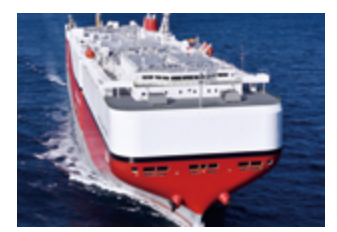
- 拡大
- CENTURY HIGHWAY GREEN
- A very large gas carrier (VLGC), which is mainly fueled by LPG and capable of carrying LPG or ammonia, with a view to transporting ammonia in the future (planned delivery in 2023)
Approximately 20% reduction in CO2 emissions compared with heavy-oil
fueled vessels
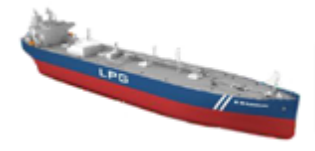
- 拡大
- Photograph provided by Kawasaki Heavy Industries,Ltd.
- Considering the introduction of zero-emission fuels, such as ammonia and hydrogen, and carbon-neutral fuels, such as bio-LNG and synthetic fuel
- Implementing trial voyages using biofuels for vessels
- Participating in a joint study framework for researching the use of ammonia as a maritime fuel that crosses industrial boundaries, such as those between shipping companies, trading companies, shippers, and manufacturers, with the aim of using ammonia-fueled vessels
- Considering the target of commercialization and the introduction of zero-emission vessels in the second half of the 2020s
- Launching collaborative research on decarbonization with JSW STEEL
- Launching collaborative research on decarbonization with Emirates Global Aluminium
- Confirming construction of hybrid EV tugboats equipped with large-capacity lithiumion batteries and generators
Zero CO2 emissions

- Developed in collaboration with French company Airseas, a spin-off from Airbus
- Considering expanding the use of this new technology, which can be installed on any type of vessel, including existing ones, to all vessels
・Installation on a cape-size bulk carrier scheduled to begin in fiscal 2022
Expecting a reduction in CO2 emissions of more than 20%
Pursuing a 45% to 50% reduction in CO2 emissions through the synergistic effect of installation on LNG-fueled vessels
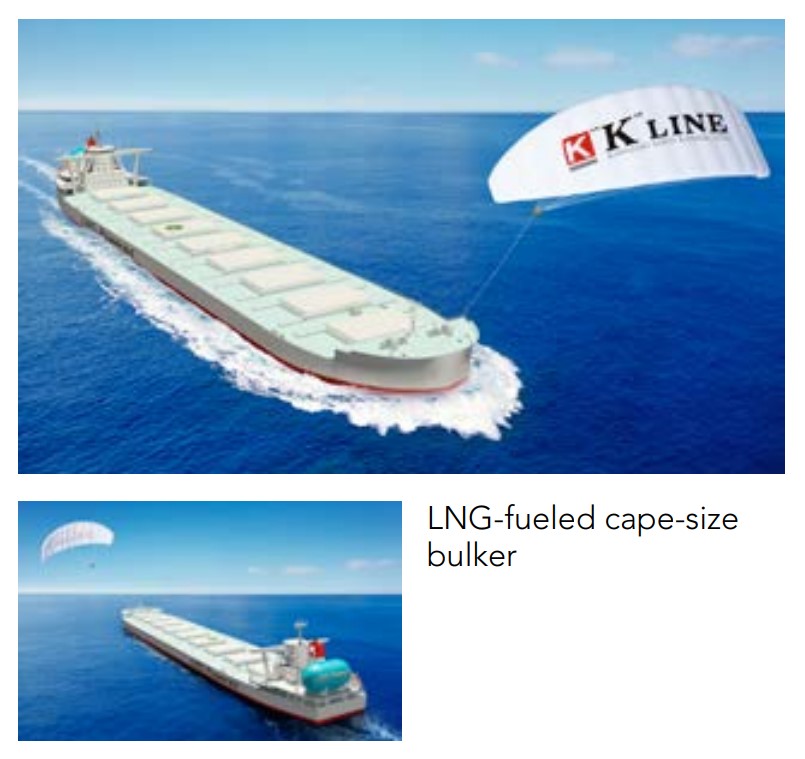
- Collects vessel operation data in real time, including fuel consumption, output power, and ship speed, and pursues the improved operational management of the vessel by using an optimal navigation system that calculates safe and fuel-efficient recommended routes
- Recently achieved visualization of performance degradation and impact of external disruption for each individual vessel using AI data analysis technology to further maintain and improve operational efficiency
Approximately 3% to 5% reduction in CO2 emissions through installation of Kawasaki Integrated Maritime Solutions

- Considering a hybrid propulsion system that combines a shaft generator, binary cycle power generation,* and lithium-ion batteries
* A method of generating electricity by heating and evaporating a working fluid with a low boiling point through low-level heat sources, such as warm water, low-pressure steam, or air, and using the steam to turn a turbine

- World’s first CO2 capture plant on a vessel installed on coal carrier CORONA UTILITY as part of demonstration projects for Carbon Capture on the Ocean (CC-OCEAN), an offshore CO2 capture and storage plant, together with Mitsubishi Shipbuilding Co., Ltd., and Nippon Kaiji Kyokai (ClassNK)
- CC-OCEAN project wins Marine Engineering of the Year (Doko Memorial Award) 2021
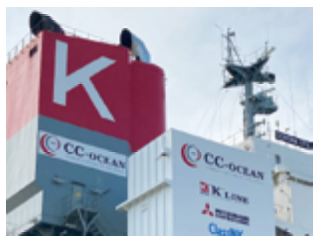
The fuel combusted in the engine to be converted into energy for maneuvering the ship is discharged into the atmosphere as exhaust gas. The thermal energy of this high-temperature gas is collected by the exhaust gas economizer to generate hot, high-pressure steam. If the steam is sent to turbo generators driven by the steam turbine and used to generate electricity for use onboard, it enables saving fuel necessary for electrical generation. Thus, this system that uses energy of the exhaust gas, which would normally be wasted, improves a ship’s energy efficiency, or the transport’s energy efficiency, enabling reduction of CO2 emissions.
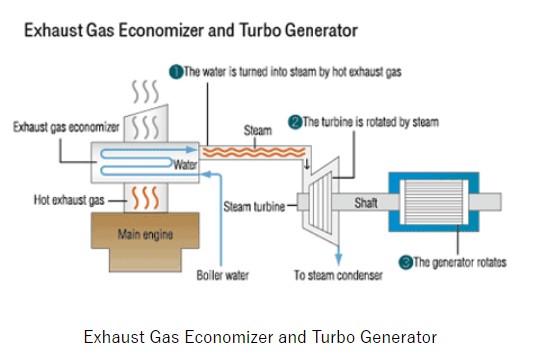
The rudder that maintains and changes a ship's direction is positioned at the back of the propeller and is continually subject to the water stream that the propeller generates. Then, if a spherical bulge and horizontal fins are attached to the rudder, it enables converting the propeller’s water stream into propulsion power. Since the propulsion power increases, that extra power permits lower fuel consumption and reduces CO2 emissions, while maintaining the service speed of the ship.
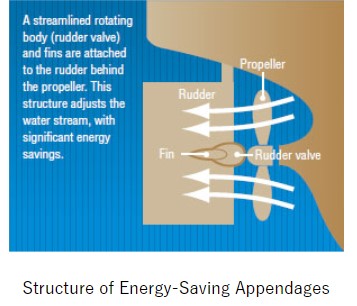
A ship is navigated to the destination port by following the course specified in the voyage plan. However, because a ship is subject to disturbances such as wind, waves and ocean current, she needs to be steered frequently to stay on course. An autopilot is a system that automatically steers the ship. It is used in areas where multiple ships do not converge, such as in mid-ocean. The latest type of autopilot is capable of learning the degree and duration of those disturbances and makes use of the data for the next steerage, thereby minimizing unnecessary operations. This reduces fuel consumption by about 1% compared with conventional units. We are striving to reduce the amount of CO2 emissions by continuing to install this state-of-the-art system in our ships.
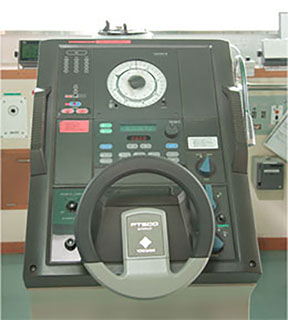
- 拡大
- Steering stand with autopilot
Crew members’ onboard accommodations and the bridge for navigational watch are air-conditioned. However, ships are made of iron, which readily transfers heat, and subject to solar heat or outside temperature. This reduces the cooling/heating efficiency of air conditioners. We therefore use heat shield paint for outer plates of the accommodations and bridges to improve air-conditioning efficiency, and this reduces the electric power consumption needed for cooling and the amount of steam used for heating, which in turn means lower CO2 emissions.
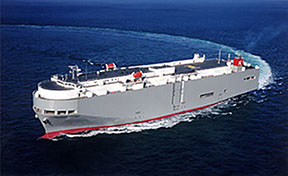
- 拡大
- Heat shield paint is highly effective for a car carrier because the areas of accommodations and upper part ofthe brdge are large.
“K” LINE has introduced energy-saving hybrid transfer cranes at its own container terminals in Japan. These cranes, which are used at terminals to sort containers by destination, convert the energy generated when hoisted containers are set down in a pre-set location into electricity that is then reused as electric power. This cuts fuel consumption by about 40-50% compared to conventional cranes and greatly reduces noise.
Transfer crane: A self-propelled crane used for moving containers at a container terminal.
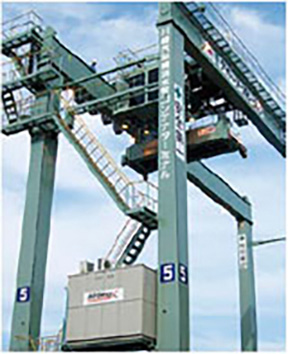
- 拡大
- Hybrid transfer crane
“BANGKOK COLD STORAGE SERVICE, LTD,” which operates in Bangkok, Thailand, installed solar panels on the roof of its 2nd warehouse in 2014. Output of the solar power system is up to 112.5kw, and total output in 2016 was 165mwh. This energy is equivalent to 13.9% of the annual electricity consumption at this warehouse and greatly contributes to energy saving. Further, “BANGKOK COLD STORAGE SERVICE, LTD” has been engaged in business operations in consideration of the environment since obtaining verification of ISO14001 in 2009.
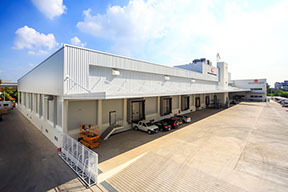
- 拡大
- 2nd warehouse of "BANGKOK COLD STRAGE SERVICE"
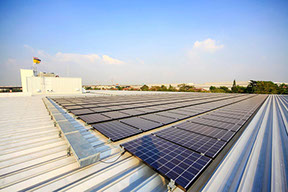
- 拡大
- Solar panels installed on the roof of the 2nd warehouse
- Raised funds through Japan’s first climate transition loan (purpose specified finance) for the LNG-fueled car carrier, CENTURY HIGHWAY GREEN, in March 2021
- Raised approximately ¥110 billion through Japan’s first transition-linked loan (TLL) (purpose unspecified finance) in September 2021. Funds to be used to finance a range of environmental countermeasures aimed at decarbonization
- Full-scale internal launch of operation in April 2021. From fiscal 2022, this has been calculated with reference to an economic index that takes into account a future earnings contribution of ¥7,000 per ton of CO2
- Promote low-carbon transition and decarbonization projects by using them as an indicator for the evaluation of investment projects
We will promote initiatives, such as supporting the offshore wind power business, participating in and creating a fuel supply network for the hydrogen and ammonia transportation business, and participating in the CO2 transportation business, as a target for supporting the development of a low-carbon and carbon-free society set out in the “K” LINE Environmental Vision 2050, which aims to achieve net-zero GHG emissions by 2050.
-
Establishment of “K” Line Wind Service, Ltd., together with Kawasaki Kinkai Kisen Kaisha, Ltd., and provision of offshore support vessels and transport vessels for off-shore wind farm businesses
-
Supporting of target set by the Japanese government for the introduction of offshore wind power generation of 30 gigawatts to 45 gigawatts by 2040 from an operational and transportation perspective
-
Launching of collaboration with Penta-Ocean Construction Co., Ltd., on ship management and other activities in the field of offshore wind power construction and maintenance
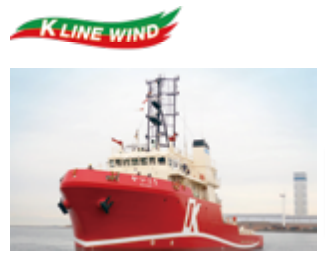
- 拡大
- Offshore support vessel
- Participation in CO2-free Hydrogen Energy Supply-chain Technology Research Association (HySTRA) with the aim of creating an international supply chain for the transportation to Japan of CO2-free hydrogen made from Australian brown coal. Implemented the world’s first verification tests for long-distance marine transportation in February 2022
- Considering re-entry into the ammonia transportation business
- Considering participation in the project to create a supply network for hydrogen and ammonia at all sites
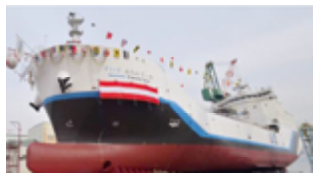
- 拡大
- Photograph provided by Kawasaki Heavy Industries, Ltd.
- Participation in R&D and demonstration project for CO2 marine transportation together with the Engineering Advancement Association of Japan, Nippon Gas Line Co., Ltd., and Ochanomizu University. Completion of construction for demonstration project vessel scheduled for December 2023

- Entry into long-term contracts with Northern Lights for two liquefied CO2 vessels.
The ships will be delivered in 2024 and will contribute to the world’s first full-scale carbon capture and storage (CCS) value chain.
- Collaborate with Chubu Electric Power Co., Inc., on a tidal energy project in Canada (aim to begin operation in 2023)
- Looking into carbon credits, carbon offsets, etc.
- Participate in international think tank Global CCS Institute
- Participate in joint CCS study in Malaysia
Note: The offsetting of carbon emissions may be carried out through an internationally accepted method in the future
(Tons)
|
Category |
2015 |
2016 |
2017 |
2018 |
2019 |
2020 |
2021 |
|
|
Scope 1 |
13,267,268 |
12,971,192 |
13,417,625 |
12,536,134 |
10,325,224 |
9,202,613 |
6,583,464 |
|
|
Scope 2 |
Location basis |
30,561 |
31,025 |
30,505 |
27,306 |
26,397 |
25,191 |
13,769 |
|
Market basis |
- |
27,669 |
25,019 |
23,135 |
26,220 |
21,780 |
13,515 |
|
|
Scope 3 |
1,564,870 |
1,551,014 |
1,516,445 |
1,424,198 |
1,304,803 |
1,219,525 |
4,566,051 |
|
Note: The scope of aggregation has been revised from 2021. Vessels not under our operations are excluded for Scope 1 and container vessels are included for Scope 3.
(Tons)
|
2016 |
2017 |
2018 |
2019 |
2020 |
2021 |
|
|
Fuel oil |
3,872,209 |
4,101,514 |
3,823,776 |
3,140,039 |
2,809,074 |
1,980,630 |
Note: The scope of aggregation has been revised from 2021. Vessels not under our operation are excluded.
(g-CO2/ton-mile)
|
2016 |
2017 |
2018 |
2019 |
2020 |
2021 |
|
|
All types of vessels |
5.31 |
5.36 |
5.32 |
4.82 |
4.49 |
4.10 |
* Index for transporting one ton of cargo one nautical mile (1,852 meters), based on deadweight tonnage (DWT).
Note: The scope of aggregation has been revised from 2021. Vessels not under our operation are excluded.
